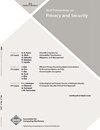不同年龄的隐私政策:1996-2021年隐私政策的内容
IF 2.8
4区 计算机科学
Q2 COMPUTER SCIENCE, INFORMATION SYSTEMS
引用次数: 6
摘要
众所周知,大多数用户不阅读隐私政策,但几乎总是勾选方框表示同意。虽然隐私政策的长度和可读性已经得到了很好的研究,并提出了许多基于自然语言处理的政策分析方法,但现有的研究在深度和范围上都是有限的,通常只关注单个时间点的少量数据实践。在本文中,我们通过分析使用机器学习和自然语言处理的隐私政策25年的历史,并对政策内容进行全面分析,填补了这一空白。具体而言,我们收集了1996年至2021年的大规模纵向隐私政策语料库,并根据其描述的数据实践、授予用户的权利以及为其组织保留的权利来分析其内容。我们特别关注最近隐私法规(如GDPR和CCPA)的变化。我们观察到了一些积极的变化,例如GDPR后数据收集的减少,但也观察到了一系列令人担忧的数据做法,例如广泛的隐性数据收集,用户对此没有任何有意义的选择或访问权。我们的工作是使隐私政策在用户端具有机器可读性的重要一步,这将帮助用户将他们的隐私偏好与网络服务提供的政策相匹配。本文章由计算机程序翻译,如有差异,请以英文原文为准。
Privacy Policies across the Ages: Content of Privacy Policies 1996–2021
It is well known that most users do not read privacy policies but almost always tick the box to agree with them. While the length and readability of privacy policies have been well studied and many approaches for policy analysis based on natural language processing have been proposed, existing studies are limited in their depth and scope, often focusing on a small number of data practices at single point in time. In this article, we fill this gap by analyzing the 25-year history of privacy policies using machine learning and natural language processing and presenting a comprehensive analysis of policy contents. Specifically, we collect a large-scale longitudinal corpus of privacy policies from 1996 to 2021 and analyze their content in terms of the data practices they describe, the rights they grant to users, and the rights they reserve for their organizations. We pay particular attention to changes in response to recent privacy regulations such as the GDPR and CCPA. We observe some positive changes, such as reductions in data collection post-GDPR, but also a range of concerning data practices, such as widespread implicit data collection for which users have no meaningful choices or access rights. Our work is an important step toward making privacy policies machine readable on the user side, which would help users match their privacy preferences against the policies offered by web services.
求助全文
通过发布文献求助,成功后即可免费获取论文全文。
去求助
来源期刊

ACM Transactions on Privacy and Security
Computer Science-General Computer Science
CiteScore
5.20
自引率
0.00%
发文量
52
期刊介绍:
ACM Transactions on Privacy and Security (TOPS) (formerly known as TISSEC) publishes high-quality research results in the fields of information and system security and privacy. Studies addressing all aspects of these fields are welcomed, ranging from technologies, to systems and applications, to the crafting of policies.
 求助内容:
求助内容: 应助结果提醒方式:
应助结果提醒方式:


